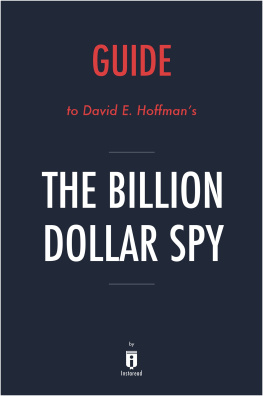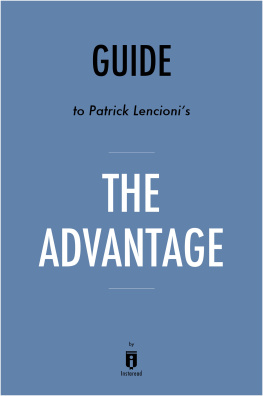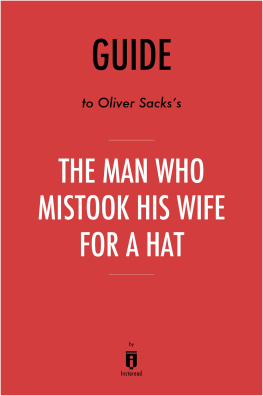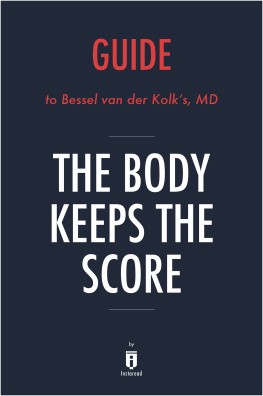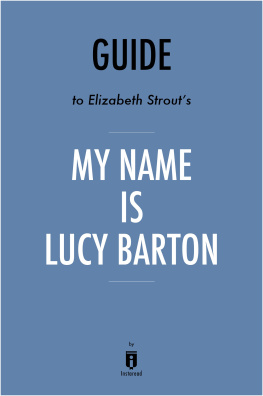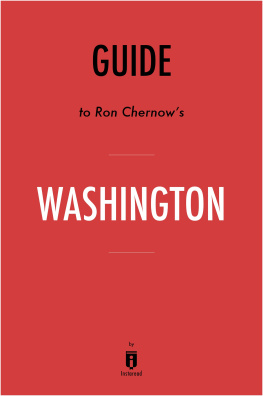Guide to
David E. Hoffmans
The Billion Dollar Spy
A True Story of Cold War Espionage and Betrayal
by
Instaread
Please Note
This is a companion to the original book.
Copyright 2015 by Instaread. All rights reserved worldwide. No part of this publication may be reproduced or transmitted in any form without the prior written consent of the publisher.
Limit of Liability/Disclaimer of Warranty: The publisher and author make no representations or warranties with respect to the accuracy or completeness of these contents and disclaim all warranties such as warranties of fitness for a particular purpose. The author or publisher is not liable for any damages whatsoever. The fact that an individual or organization is referred to in this document as a citation or source of information does not imply that the author or publisher endorses the information that the individual or organization provided. This concise companion is unofficial and is not authorized, approved, licensed, or endorsed by the original books author or publisher.
Table of Contents
Summary
The Billion Dollar Spy: A True Story of Cold War Espionage and Betrayal by David E. Hoffman chronicles the six year relationship between the Central Intelligence Agency (CIA) and engineer, Adolf Tolkachev, who spied on the Soviet Union for the United States. Tolkachev was the most productive CIA spies during the Cold War, persistent in his undertakings to ensure the undoing of the Soviet Unions aviation developments, which he personally had a hand in. He was allegedly betrayed by a disgruntled former CIA agent who gave his identity to the Soviet secret police, the Komitet Gosudarstvennoi Bezopasnosti (KGB).
While the CIA was largely meant for intelligence analysis at its outset, troubles with the Soviet Union caused the CIA to expand into espionage and covert operations. However, it was difficult to run spy operations within the Soviet Union itself because of heightened national security and suspicion. For these reasons, the CIA had trouble finding and securing agents in the Soviet Union. At the beginning of the Cold War, the CIA did not have a presence in Moscow at all.
The CIA went through a period of deep mistrust and high paranoia that threw the organization into an unproductive state. This was thanks to the tightly held beliefs of James Angleton, the CIAs chief of counterintelligence from 1954 to 1974. He was convinced the KGB had successfully deceived the CIA, which meant the CIA could not trust Soviet spies during this era.
To push the CIA forward and away from the grip of paranoia, Burton Gerber, a CIA case officer, designed a popular method to conduct personal meetings with spies, which would become crucial for managing Tolkachev in the future. Gerber believed the CIA had long ignored valuable opportunities to collect intelligence, as all Soviets who approached CIA agents with information were assumed to be KGB. The CIA began following certain rules based on his beliefs, called the Gerber rules, that signaled a turning point for the organization as the CIA could now accept volunteer intelligence within certain parameters.
In 1977, President Jimmy Carter called on Admiral Stansfield Turner to lead the CIA. Turner clashed with some at the CIA for believing technical intelligence was more reliable than human intelligence. He dealt with a few setbacks for the CIA and ordered a total stand-down in the Soviet Union, informing the Moscow station to stop all spy-running operations.
Around this time, Adolf Tolkachev, an engineer, first approached members of the CIA. He delivered notes to encourage an official meeting with the claim that he had valuable information on both ground radars and radars in aircraft. However, the first few times Tolkachev contacted the CIA he was ignored, mainly due to the stand-down. Gardner Gus Hathaway, Chief of Station in Moscow, was frustrated that the CIA could not capitalize on this intelligence. After a few attempts at contact by Tolkachev, headquarters gave permission to Hathaway to contact Tolkachev because the Pentagon was interested in intelligence concerning Soviet aircraft electronics and weapons control systems.
John Guilsher became Tolkachevs first case officer. Between March and November of 1978, Tolkachev made several drops of information that helped build trust between him and the CIA. It was also during this time that Tolkachev began making demands in exchange for his work as a spy. Then, in November of 1978, headquarters agreed to a personal meeting with Tolkachev, which signaled the end of the stand-down. In January of 1979, Guilsher and Tolkachev had the first of several personal meetings. Tolkachev began by delivering handwritten notes and diagrams of top-secret Soviet technology. Eventually Guilsher gave Tolkachev a camera so he could photograph documents instead.
Tolkachevs initial intelligence deliveries were deemed impressive by CIA superiors and other officials allowed to access the contents. In one of his letters, Tolkachev explained that he wanted to inflict the greatest amount of damage to the Soviet Union in the least amount of time possible despite having outlined a long-term plan for his involvement with the CIA.
Tolkachev also made certain requests, some that would be negotiated back and forth for several years. These included the amount the CIA would pay him for the intelligence he collected. Tolkachev was also adamant he be given a suicide pill in case he was ever captured by the KGB. The CIA stalled before giving him one. Over the years, Tolkachev also made requests for minor things for his son, such as Western music or drawing pencils, as well as things such as razors and medicine.
As it turned out, Tolkachevs intelligence was initially worth millions and later billions of dollars to the United States, and officials grew hungry for more. Tolkachevs case officers continuously walked a fine line to balance requests for information without pushing Tolkachev too hard out of a fear he might put himself at unnecessary risk.
The security at Tolkachevs office grew more stringent, looser, and then stringent again as time went on, which affected the level of intelligence output. Tolkachev was concerned about his name appearing on permission forms to check out secret documents, so he and the CIA went back and forth on forged permission slips and building passes to help him evade security. At times, the CIA and the case officers feared Tolkachev was taking too many risks to obtain intelligence.
Tolkachev and Guilshers final meeting took place in June of 1980. Soon after, Tolkachev was assigned a new case officer, David Rolph. Rolphs association with Tolkachev began with the announcement that Tolkachevs request for a suicide pill had finally been approved. Rolph and Tolkachev met on several occasions before their last meeting in December of 1981.
Gerber, who became Chief of Station in Moscow after Hathaways departure in 1980, developed a new method case officers were to use when meeting with spies. Rather than give them simple covers, such as identification as diplomats, but allowing them to spend time at the Moscow station, he chose new case officers who were new to the Soviet Union and banned them from the station so that they would not pop up on the KGBs surveillance of the building and those associated with it. He called this method deep cover.
After a May of 1982 meeting between Tolkachev and a deep cover agent, wherein Tolkachev finally received a decent replica of his building pass, Tolkachev went quiet and missed five meeting attempts. Over the summer, Bill Plunkert took Gerbers place as Chief of Station in Moscow. He decided to meet Tolkachev himself and went through an elaborate plan to fool KGB surveillance. Plunkert discovered that Tolkachev was bedridden from health issues. However, he was able to use the building pass replica to check more documents out.
Next page
